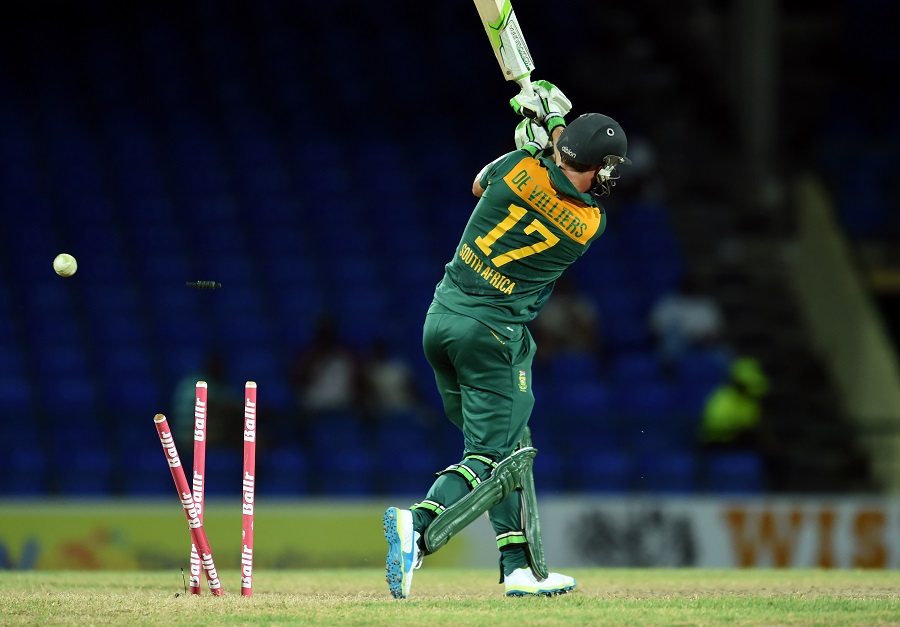Tom Sizeland rates the players’ performances, following the Proteas early exit from the Tri-Nation series.
HASHIM AMLA – 8 (241 runs @ 48.20, SR 88.60)
Difficult to complain about Hashim Amla’s performance throughout. Only one of his innings contributed meaningfully towards a victory, but what an innings it was, as he was one of the few players to translate IPL form into international form, displaying some unorthodox shots we haven’t seen from him before. The Proteas’ highest run-scorer by far at a typically impressive strike rate.
QUINTON DE KOCK – 5 (149 runs @ 29.80, SR 74.50)
Tidy behind the stumps, but uncharacteristically sluggish with the bat throughout. Made starts in the majority of the matches, and his 71 in St Kitts was well-measured, but couldn’t amass the runs, nor the firepower, that we’ve come to expect of him.
FAF DU PLESSIS – 7.5 (139 runs @ 69.50, SR 103.73)
Failed to get going in Friday’s encounter, but provided some impetus from the get-go in his first two matches, which was impressive given he was out of action for a while with a hand injury. He was in good touch in the IPL, and brought that through to the Caribbean with the best strike-rate in the tournament for batsmen who have scored over 100 runs.
AB DE VILLIERS – 3.5 (121 runs @ 24.20, SR 81.75)
Not good enough from the player his country relies so much on. To paint a picture, it was the first time in eight years that De Villiers didn’t score a fifty in an ODI series lasting more than three matches. It took him 91 balls to find a boundary. Although it didn’t affect the outcome of the match, you’ve got to ask why he was only introduced in the 41st over in their victory against the Windies. The way he utilised the spinners was commendable throughout, but why did he take off Rabada after four overs in the last game? He was in the midst of an unplayable spell, and they only took another wicket 156 runs later, leading to the defeat.
JP DUMINY – 3 (92 runs @ 23.00, SR 85.98, 1 wicket @ 66.00, Econ 7.20)
The player the fans are growing the most frustrated of. Mainly because he’s played 156 ODIs now, and he’s just not delivering the goods. His batting is a massive area of concern. No fifties in 11 innings, just one in 17. Here’s an even more worrying stat – take Bangladesh and Zimbabwe out of the records, and he’s only scored one fifty in his last 27 innings. His bowling? Well, this year he averages 141 at an economy rate of 7.76.
FARHAAN BEHARDIEN – 4.5 (101 runs @ 25.25, SR 67.78)
Behardien’s role has become a bit clearer in the side now. The idea is that he’s there to finish strong at the back-end of the innings. In reality, though, he’s there to provide stability when the top-order collapses, which happened several times in this series. The question remains, is he the best No 6 in the country? His 62 against Australia was a match-winning one, but that was about it. He’s not an all-rounder – you’re not an all-rounder if you bowl one over the whole tournament. Time is surely running out for the 32-year-old.
CHRIS MORRIS – 5.5 (56 runs @ 18.66, SR 84.84, 3 wickets @ 37.00, Econ 4.62)
Certainly a useful asset to have in the side, but his bowling was a bit off the boil, and his batting went missing when it was desperately needed lower down the order. It took him three matches to get his first wicket. He added a new dynamic to his batting when he scored 40 off 25 balls coming in at No 3 in the fourth match, but has yet to hit double figures as a No 7 batsman for the Proteas.
WAYNE PARNELL – 6 (33 runs @ 11.00, SR 42.85, 5 wickets @ 32.60, Econ 5.65)
Bowled better than his figures suggests. Generally did what was asked of him with the new ball, chipping in with a wicket on each occasion. Wayward at times, but mixed it up and his cutter which rattled Darren Bravo’s stumps in the fourth match was one of the deliveries of the tournament. Not good enough to bat at No 7, will need to do more at No 8 if he is to sustain a place in the team as a bowling all-rounder.
KAGISO RABADA – 7.5 (7 wickets @ 27.14, Econ 4.63)
Loses marks for inconsistency. To put it simply, three excellent matches, two poor matches. We can no longer talk about him as a player to watch in the future. We need to talk about him now, as he took the responsibility of leading the line for the first time in his international career in this series. I argued a case for resting him for a match, but his best performance was in the last game, when he blew the Windies top order apart with pace threatening to break the 150km/h mark. Did a similar thing to the Australians in their opener, before expensive matches against both sides.
TABRAIZ SHAMSI – 7 (3 wickets @ 25.66, Econ 4.52)
An exciting prospect, and most importantly has years ahead of him, unlike his peers. Caused mayhem with his variation on his debut against Australia and was unlucky to only pick up one wicket. Provided the perfect foil to Imran Tahir’s onslaught in his second match with a couple of scalps of his own. Proteas fans have reason to be optimistic about the spinners they have at their disposal.
AARON PHANGISO – 8 (6 wickets @ 19.66, Econ 4.84)
Easily his best period in the green and gold, and unlucky to feature in just three matches. Displayed excellent control, giving away little and chipping away with six wickets. The Proteas picked two attacking spinners in Tahir and Shamsi in that victory against West Indies, but it was the conditions that allowed it. Even though age isn’t on his side, Phangiso is a useful player to have in the locker room for all conditions.
IMRAN TAHIR – 9 (13 wickets @ 16.15, Econ 4.56)
South Africa’s best player in the tournament. His 7-45 will obviously go down as the team’s finest moment of the series, and his finest moment ever, as he secured the best ever figures by a South African in ODIs, and became the fourth-fastest to 100 ODI wickets. He claimed six more wickets from four other matches, proving to be a constant threat.
RILEE ROSSOUW – 6 (68 runs @ 34.00, SR 72.34)
Deputising for Du Plessis, Rossouw was SA’s best batsman in the first ODI, before an injury during the second match ended his tournament early. We’ll never know how much more he would have played if fit, and his batting role in the side in the future remains unclear.
KYLE ABBOTT – 5 (1 wicket @ 76.00, Econ 3.80)
Rarely lets the team down, albeit without ever really standing out. Only one wicket, but his 20 overs were bowled at an economy rate of 3.80, conceding just 26 runs for his 10 overs in the opener against the Windies. Looked out of place batting as high as No 8.
MORNE MORKEL – 3 (1 wicket @ 68.00, Econ 7.55)
Came in to the last match cold, having not bowled a ball all series. It showed, sending down six wides and bowling nine expensive overs. Took key wicket of Kieron Pollard, but more was needed from their most experienced bowler.
Picture: AFP







